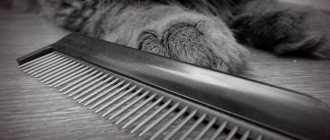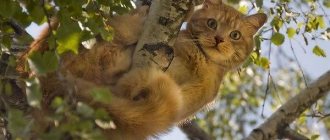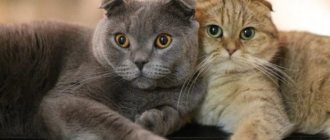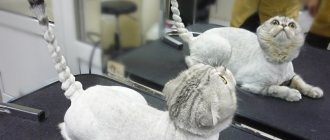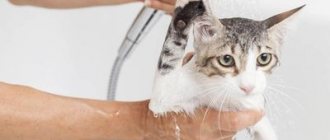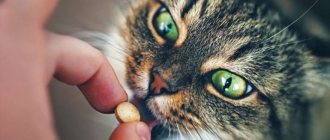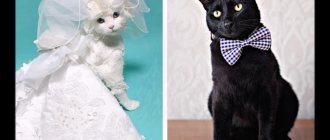The body of cats is usually covered with a beautiful fur coat, which becomes even thicker and warmer with the onset of cold weather. However, some representatives of the cat family do not have thick fur, so they need additional insulation. You can warm your cat without causing her discomfort using special clothing.
The cat suit has a simple cut, so sewing it does not require much tailoring skill. Do-it-yourself outfits will cost much less than ready-made analogues. How to correctly take measurements and make a pattern for clothes for a cat? What materials and tools will be needed for sewing?
How to sew clothes for a cat
When choosing materials to create an outfit, pay attention to the composition and tactile sensations. If you enjoy touching fabric or yarn with your cheek, then your pet will most likely like the material. To make something that is not only beautiful, but also convenient, with your own hands, you will need a little time and the ability to hold a needle or knitting needles in your hands. We have prepared for you several universal photo patterns, using which you can sew or knit many outfit options. Clothing for cats is very easy to sew if you know some universal techniques. For example, it is not necessary to create new drawings every time. Using the patterns that you will see in the photo below, you can sew not only a T-shirt, but also many other things:
- a T-shirt, if you finish the sleeves;
- a jacket for walking outside, if you add a practical hood;
- dress, if you lengthen the pattern a little.
The request returned an empty result.
To sew clothes for a pet, there is no need to constantly make new patterns. It is enough to do your job well once and then use ready-made blanks.
You can create a T-shirt, bodysuit, blouse, jumpsuit, suit and any other outfit.
You will just need to make small adjustments.
Cat in a blouse
Knitwear works well for a T-shirt. If you take a warmer material, for example, fleece, and make a larger cut for the head, you will get a jacket for walking in the evening. There is nothing complicated about this. You just need to add a little of your imagination.
Sewing clothes for a cat is easy. You need to correctly take and transfer measurements to the material, sew everything together and the outfit is ready. If you follow all the recommendations in our article, the result will shock you. How elaborate the outfit will be.
In order for a pet to wear clothes, it must be taught to them from an early age.
To do this, animal psychologists recommend rewarding your pet somehow for each trip in a new outfit, letting him know that he is doing the right thing.
Do this as needed.
Choosing a color for a cat sweater
Do-it-yourself clothes will be very useful for a cat, because they will be exactly the right size. It is equally important that the new item can include not only design, but also colors. Then you can easily create a sweater based on the character of your pet.
Active cats will like bright and rich colors . Slower and more measured cats will suit calmer pastel colors.
In this article you will learn how to create several patterns of sweaters for cats with your own hands. A warm sweater is very important for sphinxes, since their respiratory diseases are not so easy to treat.
Some tips on how to train cats to wear clothes:
- This must be done carefully and definitely not against the will of the pet.
- Things should be comfortable, not tight, but also not dragging along the floor.
- You can entice him to the sweater using food or a special cat spray with a catnip scent (found at a pet store).
Important! The sweater must be made of natural and non-electric materials.
Overalls for a cat
For this model you will need only one measurement - the length of the back (2 measurements, AB in the picture) Do not forget to try the product on the cat from time to time as you sew, adjusting the measurements to the width and length. Leave a little free space along the bottom of the legs into which to insert an elastic band.
Step 1. Draw a line on whatman paper equal to the length of the cat's back. Divide this value by eight - it will be the edge of the grid square on which you build your pattern. For example: the length of the animal’s back is 20, which means that squares must be built with sides of 2.5 centimeters. Outline the mesh, then carefully, according to the cells, transfer the outlines of the pattern from the drawing. The pattern should consist of several parts, the largest of which are the right and left sides, and the small one is a wedge that will be located on the chest and stomach (it must be sewn between the front legs).
Step 2. The overalls must be sewn in layers - for the upper part you can use low-maintenance raincoat fabric, for the lining take soft fleece or flannel. If you want, diversify the model with a hood - this will completely prevent your cat from getting wet when walking in the rain.
It is advisable to make the fastener on the upper back. This way the cat won’t be able to damage your hands when trying it on and won’t tear the zipper while wearing it.
The first stage is searching for patterns and preparing tools
To make a beautiful outfit for your pet with your own hands, you need to choose not only the type of clothing, but also the material. Both cases have their own nuances.
Choosing an outfit type
The choice of type of clothing directly depends on the purpose it serves, as well as on the season. For summer, you should choose T-shirts or a vest; for spring/autumn, a sweater, vest and light jacket are suitable, and for winter, a warm winter jumpsuit.
Fabric selection
The choice of material must be made based on the following criteria:
- purpose: everyday wear, at exhibitions, protection from dirt;
- season: summer, autumn and winter things;
- characteristics of the breed.
Based on these parameters, the requirements for the fabric are determined: wear resistance, moisture resistance, ease of cleaning, heat retention, fading in the sun.
Regardless of who will wear the clothes (kitten, cat or cat), it should be sewn or knitted from natural materials. Otherwise, there is a risk of developing allergies and dermatitis.
Most often, things for cats are made from viscose, cotton, linen, wool and synthetics. There are mixed models, the creation of which uses several types of materials at once. Each material has its own advantages and disadvantages. Therefore, carefully read the description of the selected fabrics.
If you need to sew a suit or any other type of clothing, then you will need a needle and thread and scissors. A sewing machine will help speed up the work process and make it better. If knitting will be used, then knitting needles and a hook are needed.
How to take measurements
To knit or sew, you need to take measurements of the animal. A knitted or sewn item of clothing is made to the same measurements. Therefore, it is enough to measure your pet correctly once.
The following quantities are required for operation:
- neck girth;
- back length (from the neck to the beginning of the tail);
- body girth. Measured just behind the forelimbs.
Other measurements are additional (for example, the distance between the paws). They arise if you need to sew a special suit. For standard outfits, these three measurements are quite enough.
When measuring the size of an animal, there is no need to leave extra centimeters in reserve. All measurements are carried out with the same centimeter, which during the process of taking measurements is in a free, and not in a tense, position. The result will be a small reserve, which will be enough for seams.
With the help of successful patterns, even an owner with no experience in sewing can create original clothes for his pet. Almost any clothing for a cat can be made with your own hands if you have successful patterns and patterns. Therefore, the first stage of work is to search for patterns and prepare materials.
Regardless of what type of clothing will be made for the cat - a shirt, dress or overalls, the owner should not forget that the clothing must first of all be comfortable and not cause discomfort to the pet. Therefore, when taking measurements and drawing up patterns for animal clothing with your own hands, the owner needs to be extremely careful and careful.
Taking measurements should be done using a centimeter tape. It is important to obtain the following measurements:
- neck and back parameters;
- girth of the chest, abdomen and torso;
- paw circumference;
- head circumference;
- width between paws.
You should take care of consumables and tools in advance. If a costume for adult cats or cute clothes for kittens is sewn with your own hands using a sewing machine, then in the process of work, in addition to fabric, the master will need other accessories:
- cutting tools;
- needles;
- accessories;
- threads;
- tape measure;
- crayons;
- overlock;
- sewing machine;
- pattern for creating patterns and transferring them to fabric.
How to train a cat to wear clothes
Nature did not instill in cats the desire to wear dresses or pants, so accustoming a pet to clothes lies entirely with the owner of the animal. You need to accustom your pet to clothes as early as childhood. This is how the kitten remembers that clothes are normal. If the cat has matured, then it needs to be trained in stages. First, the animal is accustomed to some simple clothing (vest, T-shirt, etc.). Moreover, this should be dressing for 5–10 minutes, but several times a day. If the animal immediately begins to protest, then it can be persuaded (caress it, treat it with something, etc.).
Some cat breeders drip valerian onto their cat's clothes. This makes it easier for the cat to come to terms with the “inevitability.” By the way, this method will come in handy later. Sometimes even animals with fashionista experience refuse to wear some new thing; in this case, the thing can be made “more familiar” if it smells of something interesting, for example, valerian.
Well, I have one cat that has been trained since early childhood. Even at 3 weeks, I dressed them in “blouses” from socks. The second kitty put on clothes for the first time at about 8–9 months, when it was very cold. First, I cut out the front holes for her paws from the same thin and light socks and put them on her. The result is a blouse. She got used to such clothes and slowly began to wear more “complicated” things. The main thing is that pussies, in principle, do not need hind legs, i.e. they must be open. Go for it! Everything will work out! You can carry him in his clothes in your arms, put him on the bed to be with him, then lower him to the floor and let him lie around and fall.
https://sfinx-cats.ucoz.ru/forum/11–3236–1
Video: cat in a vest
You can reward your cat every time she allows you to wear clothes. And it doesn’t have to be food. Remember how you pamper your pet (cartoons, walks, favorite toy). You can use any tricks. However, it is important not to overdo it. If you use a trick and thereby do not justify the cat’s wishes, she will remember that clothes are associated with her humiliation, resentment and disappointment. Sometimes you can follow the animal’s demands and take off her outfit every time the cat asks. But there should be many such attempts. Sooner or later, the pet will get tired of resisting and will put up with the clothes.
Video: a cat is fitted with a suit that doesn’t fit
If your pet “dies” while wearing clothes, falls to the side or crawls, then this is not necessarily a simulation. Perhaps the outfit does not fit, interferes with the paws, or is not cut at all. And if the clothes also have fasteners (snaps, buttons, zippers), then there is a risk of pinching the animal’s skin or “biting” a tuft of fur. Of course, in such cases, every small movement will cause pain to the animal. Cats cannot express in words what exactly is wrong, so be careful when choosing clothes and listen to your pet’s “requests.”
Even a “bald” cat doesn’t need to be dressed. This is how the nature of animals works: one cat has fluffy fur, while another has short or no fur. However, cat clothes have already justified themselves, and their need has long been confirmed. Therefore, whether or not to dress a cat is your choice. But in any case, you need to remember that clothes should be useful to the cat, and not vice versa.
What measurements need to be taken and how to do it?
To create a pattern you will need the following parameters:
- neck circumference (NC);
- chest girth (CG);
- waist circumference (WT);
- back width (ШС);
- pelvis width (W);
- back length (DS);
- length from collar to paw (LOW);
- length from collar to chest (DOG);
- length from waist to tail (DTK);
- sleeve length (SL);
- front paw girth (FPL);
- hind paw girth (HLP).
Measurements are taken from the animal using a measuring tape. For this procedure, it is better to invite an assistant who will hold the cat in place at the time of measurements.
Taking measurements
To take measurements correctly it is recommended:
- Place the cat on its paws and take a tailor's meter.
- Take measurements of the neck circumference and length of the animal. The last measurements are taken from the base of the pet's neck to the base of its tail.
- The length of the body is measured across the abdomen, and its girth at the widest point.
- The girth of the paws is measured at the base.
These are standard measurements. Sometimes you may also need:
- length of front and hind legs;
- Head circumference;
- distance from the base of the neck to the eyes. If we are talking about making a hood.
Scheme of taking measurements
Before proceeding to sewing and cutting the fabric, it must be washed and ironed. You will be able to see if she is molting, or maybe even sitting down. Fold the fabric in half in the direction of the grain.
Start cutting out large parts at once, and then small ones.
During the cutting process, pin the pattern in several places so that it does not fall off.
Pajamas
Sweep the finished parts with bright threads of a different color and try on the outfit on your pet. If all is well, you can sew. If there are mistakes, clarify them with chalk and correct them.
Comfortable and stylish pajamas
Cats are heat-loving animals, especially if you have a Sphynx living in your apartment. Pets with smooth coats require special attention, so comfortable pajamas are the ideal solution for caring for your four-legged animal. For overalls, any soft fabric is suitable, for example, flannel, fleece or knitwear; it is better to use waterproof options. The pattern of this outfit for a cat is printed on A4 sheets or applied independently to whatman paper.
Step 1. This model consists of several parts. Part 1 – back (GZ), the value is equal to the length of the cat’s back; you can also place a fastener along this line (for this you need to leave an allowance of two to three centimeters). Detail 2 (IZ) – belly measurement, folded along the IZ line.
Step 2. Place the pieces together and sew. The lines AG, BV, VD, DE are sewn together, the rest remain free (AB and EZh are the paws). The ZhZ line also needs to be sewn, but leave a small hole for the tail. When the work is ready, sew on a zipper if desired.
Some tips for sewing: make the seams overlap, using a zig-zag stitch, in this case they will be softer and will not disturb your cat. The lower edges of the paws and throat can be supplemented with a pre-prepared knitted ribbon. If the pajamas are made from fleece, the fabric does not need to be improved in this way.
Why does a cat need clothes?
Street and many purebred cats have thick fur with an undercoat that keeps them warm even during winter walks. However, there are breeds with a modest coat or no coat at all. As a rule, these are elite hybrid cats whose ancestors lived in Southeast Asia or on the African continent.
Their natural habitats are characterized by hot weather and the absence of winter. In such a climate, individuals with short hair with virtually no undercoat survived better. In addition to natural selection, these cats were worked on by breeders who, through crossing, developed hairless breeds such as the Sphynx.
These exotic animals are also in demand in Russia. Once in our cool climate, hairless cats feel cold and can catch a cold, so owners should take care of warm clothes for them. A jumpsuit or other type of clothing will keep your cat healthy and help her feel comfortable in any weather.
The first stage is searching for patterns and preparing tools
If you are not a seamstress, don't worry. On the Internet, find a pattern for an outfit you like for a cat and print it out. Transfer all the details onto a sheet of paper in a box.
Cut out the blanks. Place them on a piece of paper that will fit the pieces in the right size for your pet. You can also use graph paper. Zoom in by adding the distance from each edge according to your measurements. Attach the resulting patterns to your pet.
Based on the measurements taken, a pattern is made. You can do it easier and use a regular sock. Here you need to put the sock and mark the holes for the paws with chalk. Afterwards they are carefully cut out. The result is a ready-to-wear product.
There is also a more complex scheme. In this case, using the measurements taken, a trapezoid is drawn with holes for the front legs. Here you need to correctly determine the location for the fasteners. This is how vests, sweaters and jackets are made. The latter products require sleeves.
The overalls are made using a more complex pattern. It consists of two parts (bottom and top) that need to be sewn together. Such products are complemented by zippers, pockets, and sleeves. The main parameter here will be the length of the back. The resulting value is divided by 8. The result will be the sides of the grid square where the pattern will be built. All dimensions must be carefully and accurately transferred to this grid.
Using these patterns you can easily make any type of clothing for your cat.
Cute vest for a cat
To build this model, you need to know the circumference of the cat's neck, the length of its back, the circumference along the bottom, and the length between the legs. If you want to use clasps, leave a small allowance for them.
Step 1. Mark the neck circumference measurement on a white sheet, but not with a straight line, but with a slightly rounded line. Exactly in the middle, draw a vertical line equal to the length along the back. The bottom part of the picture is the bottom of the product, its value is equal to the circumference of the cat’s lower body. Divide the “distance between the paws” parameter by 2, the resulting figure is the line to the beginning of the holes for the paws (on both sides of the vertical line). The dimensions of the vertical length of the vest depend on how long you want to give the product.
Step 2. Transfer the data to the selected fabric by attaching the pattern to it. Cut the resulting blank with scissors, then sew the product by connecting two opposite sides AB and CD. Cut out the piece, leaving a little space for the seam, then cut out the armhole for the paws, then hem or border the edges of the piece.
Pattern of clothes for a cat: a few simple ideas
- The simplest pattern for cat clothes is if you take as a basis a pant leg or sock of suitable sizes, mark holes for the paws on them with chalk, and then carefully cut them out using nail scissors.
This will save time on drawing up the pattern and will only require stitching the edges, sewing on the necessary fasteners, decorations and any useful accessories, for example, a loop for a leash.
- The second simple pattern of clothes for a cat in this photo:
To create such a pattern, you will need to measure the cat's neck circumference, back length, bottom circumference and distance between the legs. It is necessary to provide allowances for the fastener and correctly mark the holes for the paws.
Choosing fabric for clothing
The right fabric is half the success. But first you need to decide:
- what breed is the pet;
- how old is he;
- what time of year the item will be worn;
- It will be casual wear, you need to go to a celebration or for walking on the street.
Any fabric has its pros and cons:
- Cotton and viscose will not cause allergies, are pleasant to the touch and to the body, and stretch well. But they wrinkle a lot, take a long time to dry and become deformed.
- Linen is hygroscopic, hypoallergenic, thermally conductive and capable of reflecting ultraviolet radiation. But when worn, such fabric is whimsical. It wrinkles quickly, after washing it often shrinks and crumbles in the cut area.
- Wool is a material of natural origin, characterized by excellent heat retention properties. One of the disadvantages is the formation of pellets during wear.
- Synthetic fabric at least wears well, dries quickly and stretches, and is able to quickly absorb all the smells and aromas of the surrounding world. It is electrostatic and quite often causes allergies in pets. You need to be careful with this fabric.
- A mixed material that has absorbed most of the positive qualities of natural fibers.
It follows from this that the material for sewing clothes for a cat must be of natural origin.
It is better not to take fabric that does not stretch well, as it will be uncomfortable for your pet.
Nylon, nylon, synthetic fabrics are highly durable and have the ability to retain the shape of the product for a long time, but can cause allergies
You should also avoid purchasing products that:
- has an unpleasant and pungent odor;
- wrinkles quickly;
- has an openwork base;
- takes a long time to dry after washing;
- crumbles along the edges of the cuts;
- rustles.
Depending on the season when the clothes will be worn, it is recommended to pay attention to the following material:
- winter: insulated stretch, knitted fur and raincoat fabric with water-repellent impregnation;
- spring: taffeta and raincoat fabric with water-repellent impregnation;
- summer: mixed fabrics consisting of cotton and viscose;
- autumn: microfiber, denim and water-repellent raincoat fabric.
Silk is most often chosen for formal wear.
Fabric cutting, fitting and sewing
Before cutting, the fabric needs to be washed and ironed to make sure how much it shrinks. In this case, you should definitely take this into account when sewing and select a slightly larger size than the animal needs.
The layout of the blanks is carried out on the fabric folded in half from large elements to smaller ones so that the direction of the grain thread becomes parallel to the edge of the fold.
Then do the following:
- secure the paper template with pins to the fabric and carefully trace the design;
- then cut out all the necessary parts, not forgetting the seam allowances;
- sweep them away with a bright thread and put the resulting clothes on the cat;
- If there are any problems, apply the markings necessary to correct them with chalk.
Well-fitted clothing items can be finally put together. First, fasten the upper, located on the back, and the lower, running along the stomach, halves of the suit. The seams on the sides and in the shoulder girdle are sewn with a zigzag stitch with flat overlapping stitches. The width of the armhole must be selected depending on the purpose of the item of clothing, narrowing it for a winter version of the suit, and widening it for a summer T-shirt.
Then you need to process the edges of the clothing. To do this, you can use a braid with an elastic band. It is attached from the front side with the same zigzag stitches, stretching it a little before doing so, so that the braid does not gather and compress the edges too much. This will not only prevent the edges from fraying, but will also be a nice decoration for your cat costume.
The last stage is sewing fasteners and accessories to decorate the costume. There are a large number of fasteners that you can choose from for your cat suit. There are several recommendations in this regard, but first of all it is necessary to take into account the breed of the animal.
The zipper is best for smooth-haired pets, otherwise the hair will get stuck in the mechanism. In the same way, hairs will linger on Velcro. Universal fastenings are buttons that can be placed either on the back or under the chest of the animal.
After completing all these operations, you will make a luxurious costume for your pet.
Correction of a station wagon pattern
Using the obtained values on paper (graph paper), the pattern found on the World Wide Web is adjusted: the distances are reduced or increased. Leave seam allowances. Having cut out the parts, they are applied to the model cat; if necessary, corrections are made. To avoid alterations to the drawing, experienced craftswomen advise taking a series of measurements at once.
Another important point is the peculiarity of the fabric. If knitwear is selected, then no adjustments are needed. When using non-stretch material, allowances are added for sewing in the fastener. This can be a zipper, Velcro, or traditional buttons that require more painstaking work - making loops.
Clothing material is pre-washed and thoroughly ironed. The pattern is applied to the wrong side of the fabric, folded along the grain thread. The paper is fixed with pins, the contours of the drawing are outlined with chalk, then the blank is cut out. The details are swept away with contrasting threads and a fitting is done. All errors are corrected with chalk.
If the future outfit does not restrict movement or warp in inappropriate places, then start sewing. Sew on a fastener: zipper or Velcro (optimal for bald creatures), buttons, snaps. Then the side and shoulder seams are sewn down. They are overlaid or processed with a zigzag stitch, made flat, attached to the details. The neckline, armholes and bottom are trimmed with braid or strips of the same fabric, the latter being cut diagonally. If desired, this pattern can be changed a little - add sleeves, a hood or a skirt.
Clothing patterns for cats are so undemanding that some loving housewives immediately sew a bunch of multi-colored wardrobe items for their favorites. However, it must be understood that everyday wearing of outfits is not recommended: even pets remain animals, for which any “cool outfit” is an incomprehensible, often disturbing, thing. This is the opinion of the main cat experts - veterinarians and behaviorists.
Sewing instructions
Let's start with how to sew a costume for a domestic cat with your own hands. The following instructions must be observed:
- Before starting work, the material is ironed. This will help assess the degree of fabric subsidence and determine the supply of material for seams;
- the paper template is fixed on the fabric folded in half. You need to go from large fragments to smaller ones and parallel to the shared thread;
- then the fabric is cut according to the previously created pattern;
- the cut out elements must be swept away with a bright thread. Now the resulting template needs to be tried on the animal and assessed how well it fits on it. If necessary, the markings are corrected;
- fragments of clothing that fit well together are finally sewn together. You can sew them on a sewing machine;
- First, the outer and inner sides are sewn together, and then they are combined into one product. All seams should face inside the lining. This way they will not rub the pet when walking;
- Next, the fasteners are sewn on. If a zipper is used, it is carefully sewn in at the stage of connecting the outer and inner parts of the item. It is only suitable for smooth-haired breeds.
Now you can try your creation on your pet.
Cute summer t-shirt
In the summer, a beautiful, stylish T-shirt will be ideal for your smooth-haired cat - but this model is most suitable for sphinxes, whose skin needs to be protected from direct sunlight. How to make a T-shirt for a cat with your own hands? First, prepare a light fabric, use knitted options. Draw the diagram yourself or print it out, cut it out and draw it onto fabric. Then proceed according to the instructions:
Step 1. As in the previous version, the GZ line is the length of the cat’s back. Fold the back (part 1) in two layers, cut it out, bending along the dotted line. Remember that the product should not interfere with the animal’s movement - if the cat is well-fed, make the pattern a little wider. Also cut out the belly (part 2) with a fold along the IZ line.
Step 2. Place the two parts together and sew along the lines BVD, AG. Use a zig zag stitch. Leave the lower part of the product, as well as the sleeves and neckline as is, but if necessary, the lower part and sleeves can be hemmed.
DIY clothes for the sphinx - we knit and sew using a universal pattern, photos and videos
By nature, cats are endowed with a luxurious and warm fur coat, but there are times when it is necessary to insulate the animal, for example, during transportation. Or a breed of cat, such as the Sphynx, does not have a warm coat, so it needs additional heating. They need to dress not only when going outside, but also while in a cool room. The selection in pet stores exceeds all expectations, but the clothes made for the Sphynx will be unique and will be ideal for your own pet, because you will make it with your own hands.
A cat's wardrobe can consist of both knitted items and those made from ready-made fabric.
How to tie things for a cat
You need to knit clothes for domestic cats according to the same principle as for people. You can knit and crochet. Based on the previously taken measurements for sewing the product, a pattern of the desired outfit is made and it is calculated how many loops there will be in a row. You can make several loops to determine your 1 cm step.
Sweater
A blouse or sweater is knitted in parts. First, the main part is knitted, to which the sleeves are then attached. With a vest, things are much simpler. Here it is important to correctly measure the waist circumference of the animal. You need to start from the front. If your knitting skills are weak, you need to use a simple pattern. Experienced people can take on more complex patterns.
cap
To knit a hat or beret, you need to measure the circumference of your head, the distance between the ears, and the distance from the back of your head to your forehead. Based on these measurements, a product pattern is made. Knitting is done according to the same principles as a hat for a person.
If you wish, you can sew or knit a wide variety of clothes for your pet: a dress, a sweater, a T-shirt and even a winter overall. The main thing is to take your measurements correctly and strictly follow the above instructions.
Dress for a cat: we make an outfit with our own hands
To participate in exhibitions, tailed pets are well suited for a fashionable dress that can be created at home. This dress can be sewn using a standard pattern. Choose any soft-feeling fabric, the size of which should depend on the size of the cat itself.
Step 1. For the pattern you will need the length of the cat's back. Divide this parameter by ten - the resulting figure will be equal to the size of the cell. For example, with a back length of 20 centimeters, you will get a square with sides of 2 centimeters. Make a line on a piece of paper, place the sides and bottom there (as shown in the picture). Take into account all the edges and carefully count the number of squares so as not to make a mistake.
Step 2. You should have three parts - two sides and a bottom. Cut out the sides and bottom, then sew them together. The incision is present only on the upper part, which is located on the neck.
Step 3. Sew on a beautiful decorative button if you want to further decorate the dress.
Don't make the dress too tight, especially if the fabric is non-stretchy. Also, the animal may become confused in its movements if the dress is too loose. You should not think about making a dress that is too fluffy - such options are only suitable for holidays or exhibitions, during which the cat will not be able to move, but will sit in one place.
When making a holiday suit, you can sew it from a new beautiful fabric, and for daily wear you can use an outfit from old things. Your cat will find it easier to accept things that smell familiar.
Obsessive desire or necessity?
An outfit for a cat should, first of all, perform a protective function, which is to warm the body. For smooth-haired breeds and sphinxes, clothing is the only option that protects against hypothermia, since, due to their small fur, their thermoregulation is weakened. Therefore, to maintain body temperature at the desired level, animals need to create comfortable conditions.
For warmth
During the summer, such pets are exposed to sunlight. In this case, a suit made of light fabrics is suitable. It will protect the cat's sensitive skin from ultraviolet radiation and thereby prevent it from getting sunburned.
Long-haired animals do not need clothing. However, the reality is that fashion trends have spread to pets. This is especially true for cats that often participate in exhibitions. In an effort to emphasize the beauty of their pet, owners sometimes dress them in unique outfits. Cats dressed in such attire evoke tenderness and positive emotions. But in pursuit of aesthetics, some owners do not think that these clothes can cause discomfort to the animal.
The way out of this situation would be to create an outfit for the cat with your own hands. First of all, it should be comfortable and not hinder movement. This pet needs to be measured correctly.
Step-by-step instructions for creating crochet sweaters for cats
A convenient guide that will allow you to quickly make a new and very warm thing for your beloved family member.
Schemes are provided for each model and convenient step-by-step production.
Red crochet sweater for a cat
A very bright model for a bright nature. Decorates and warms your cat. The model is fitted, stretches and does not restrict movement. There are fasteners (buttons) along the back , so putting on and taking off will be easy and not scary.
To work you will need:
- 100 g of natural wool yarn;
- hook number 3.
Scheme 1
This blouse is knitted in square fabric. Next, buttons are attached and small sleeves are knitted in the armholes.
Scheme 2
The model should be created step by step like this:
Canvas to armhole
Crochet 48 air loops, this is exactly how the jacket will be around the circumference . Next, lift in three loops and do the first 2 rows according to pattern number 1. These are simply double crochets in each lower element of the row. Then go to pattern number 2. It is very similar to the previous one, only one air loop is now added between the columns, and the columns themselves will be knitted between the columns of the previous row. Knit 6 rows like this. After each row, decrease 2 columns (one from each edge).
Armhole
For armhole cuts, you need to knit the middle 6 stitches according to pattern number 1 to a height of 6 rows. Next, step back from this protrusion two elements to the right and left and alternately knit identical rows (6 pieces in total). Then combine into fabric and knit a collar.
Gate. After the armhole is completed, knitting continues according to pattern number 2. In every second, decreases of 2 stitches begin again, in the same way. It is necessary to knit 3 rows according to the given pattern. Next, go to pattern number one and knit 2 rows, but there will be decreases in each row of two stitches along the edges.
Sew buttons. The model requires three buttons on the back . For them, knit three loops along the edge of the fabric, not too loose so that they do not unfasten.
Sleeves. Cast on loops along the edges of the armholes under the sleeves and knit 2-3 rows with single crochets without increasing or decreasing. They shouldn't turn out tight.
Here is the finished product. Despite the fact that the sweater was not knitted in the round, it does not require assembly . Just fasten the buttons and the cat can frolic and not be afraid of the frost.
Sweater with pattern
Before you start knitting a sweater, take a tape measure and measure the volume of your pet's neck and the approximate length of the sweater. When you make a cutout for the neck, do not make it small, otherwise the cat will be uncomfortable.
To work you need:
- knitting needles number 3.5
- circular needles number 3.5
- yarn 100 grams (wool or 50/50 with acrylic)
- needle
Let's get started
The main pattern is stockinette stitch. Knit over knit, purl over purl. Knitting density: 16 loops / 20 rows = 10 / 10 centimeters. We knit in 2 threads.
Let's start work from the front. We put 25 loops on the knitting needles and knit them with an elastic band, knit 1. 1 purl. 3 centimeters. Then we continue working with stockinette stitch to a height of 10 centimeters. The pattern has it all. 13 centimeters from the edge, to form sleeves, we cast on 18 loops on both sides of the fabric (a total of 61 loops on the knitting needles). We knit 10 centimeters exactly with the front ones and for the neckline we close off 21 loops in the middle. (20 loops remain on the knitting needles). In the next row, add 28 stitches above the closed stitches. (There were 68 loops on the knitting needles). Knit another 10 centimeters in stockinette stitch with an even fabric and bind off 18 stitches on both sides. (There are 32 loops on the needles). After another 10 centimeters, elastic 1/1 (k1, p1). Knit an elastic band 3 centimeters. Close the loops without tightening them too much.
Sew the side seams and sleeve seams. Making a neckline: cast on loops on circular knitting needles and knit as many centimeters as you want for the collar. You can make the collar high, or you can just make it a few centimeters. We knit with a 2/2 cm elastic band. The main thing is that the cat is comfortable.
The video provides detailed information on how to crochet a sweater for a dog, but this sweater is also suitable for our beloved Sphynx .
Video “Clothes for cats”
This video shows how to sew a cute T-shirt for a cat with your own hands, and also gives useful practical tips on sewing clothes yourself.
Many owners from time to time dress up their beloved cats in a variety of cute and practical clothes. Cats in cool clothes are the new rage. You can create clothes for a cat yourself - it’s easy, interesting and doesn’t require financial expenses that hit your wallet.
Together with your pet, you can realize the most unusual ideas and ideas, and also turn creating clothes into a real hobby!
How to choose fabric?
Cat outfits can be made from any material. Synthetic products are quite durable. They can withstand washing at high temperatures without changing shape. But this fabric has electrostatic properties and is not suitable for furry animal costumes. In addition, synthetics can provoke allergic reactions. Therefore, it is better to sew clothes for cats with your own hands using natural materials, such as:
- Cotton fabric. Soft fabric with excellent hygroscopicity. Cotton products are quite practical and even after repeated washing they do not lose color and shape.
- Viscose. An artificial material made from natural raw materials that has the same properties as cotton.
- Wool fabric. An excellent option for sewing a winter wardrobe. Retains heat well, does not wrinkle and is resistant to stains. During long-term use, pellets form on its surface. However, this drawback can easily be eliminated using a conventional razor.
- Linen. 100% natural material that is hypoallergenic. Conducts heat well and protects from sunlight. The fabric requires delicate care, so such clothes must be washed in water at room temperature, otherwise the product will shrink in size.
Another option is mixed fabrics. They contain about 40% cotton, the rest are synthetic fibers. This combination gives the material properties such as strength, elasticity, wrinkle resistance, and damage resistance. Items made from this fabric are practical and have a long service life.
Bride
If you need to sew winter clothes, then it is better to use synthetic winterizer as insulation. It is soft, lightweight, does not absorb odors and does not require special care. Holds heat well and is resistant to deformation.

